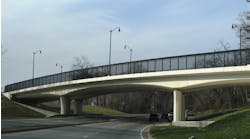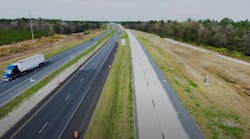I-69 in Indiana owes a big debt to the Indiana Toll Road. Not literally but metaphorically.
Leasing the Indiana Toll Road in 2006 to a private concessionaire for a lump-sum payment gave Gov. Mitch Daniels $2.6 billion to kickstart the 10-year Major Moves highway construction program. Part of that money went to beginning construction of the first section of I-69 between Evansville and Oakland City in 2008.
The first three sections—67 miles—of the interstate opened to traffic last November, several years ahead of schedule and nearly $80 million under budget, Daniels said at the grand opening ceremony. Ultimately, the new interstate will stretch from Evansville to Indianapolis.
The I-69 corridor project, in six sections, is one of those projects that has lingered in planning for many years.
“In many ways, some could argue, the efforts behind this project began decades ago,” Will Wingfield, statewide communications director for the Indiana Department of Transportation (INDOT), told Roads & Bridges. “In the late ’90s were some of the efforts that led us to where we are today with the Tier 1 environmental impact statement [EIS]."
The final EIS for Evansville to Indianapolis was completed in 2003 and was approved by the Federal Highway Administration (FHWA) in 2004.
“From that point forward was the big question mark of how to fund the project. Some of INDOT’s long-range plans showed construction potentially not beginning until 2017 at the earliest. That changed significantly when the Indiana Toll Road was leased in 2006 . . . That kickstarted construction.”
The Major Moves program provided $700 million to fund construction of the project from I-64 (Evansville) to U.S. 231 (Crane)—sections 1-3. Major Moves expires at the end of 2014. After that, funding for sections 5 and 6 is unkown.
Indiana’s new governor, Mike Pence, who was elected last year and inaugurated Jan. 14, 2013, has firmly stated his commitment to seeing the Major Moves program and the I-69 corridor through to completion.
Section 5, from Bloomington to Martinsville, currently has a draft EIS open for public comment. Section 6 will take the corridor from Martinsville to Indianapolis. The Tier 2 EIS studies for sections 5 and 6 are under way. The FHWA issued a record of decision in March 2004 approving the corridor selected in the Tier 1 study.
Fits and starts
Southwest Indiana’s expansive, rural terrain and underserved universities and businesses made it a good candidate for a new interstate.
“It is the largest portion of our state that is not served by this type of four-lane divided highway,” Wingfield said. Its rural character may be why it was “left behind by the original interstate system,” Wingfield said, but now the area stands to benefit from improved access to jobs, education and health care. “Indiana University, the University of Southern Indiana, Oakland City University, among others are all along this corridor, so access to education is certainly a big benefit, particularly for parents who are sending their kids to college driving along winding country roads with a lot of coal trucks, which is a big industry in southwest Indiana.”
As with so many large highway construction projects, I-69 has met with some resistance. The project drew some criticism for how it might affect the Indiana bat, a mammal about the size of a small mouse but with a wingspan of up to 101?2 in. The bats give birth among the trees and hibernate in caves in southern Indiana and 20 other states. About 10% of the world’s population of Indiana bats live in Indiana. Groups such as Citizens for Appropriate Rural Roads feared the construction would harm the federally endangered species.
“Section 4 is in the habitat of the endangered Indiana bat,” Wingfield said. “As part of our mitigation efforts, we purchased several times more land for mitigation than we did for the roadway itself. Just in Section 4, the road takes up about 1,100 acres; we purchased something near 3,800 acres for mitigation, including some of the top habitats in the state for the endangered Indiana bat, some of the caves.
“Some of the land is already pristine: forests, streams or wetlands. As such, we’re purchasing a preservation easement in perpetuity on the property,” Wingfield continued.
“Some other properties may be purchased for the purpose of restoration, where we’re restoring stream banks or planting trees in what would otherwise be farm land in an effort to mitigate the impacts of the highway.”
It runs through a floodplain
INDOT also took measures to mitigate impacts to the Patoka River Wildlife Refuge.
“As part of our environmental commitment to minimize the impact on that area, we are building a 4,400-ft-long concrete-beam bridge spanning the entire floodplain of the Patoka River,” Wingfield said. “It’s actually not just one bridge; it’s two, one for northbound and one for southbound lanes; the longest bridge in the corridor.”
“We made a commitment not to put any of the columns into the water,” Brian Malone, INDOT’s project manager for the I-69 corridor, told Roads & Bridges.
The bridges are twin four-lane bridges with shoulders. The southbound bridge has 31 spans in it; northbound has 30 spans.
There are two columns per pier. Kokosing Construction of Fredericktown, Ohio, was the contractor on the design-build bridge project. The designer for the bridge was Janssen & Spaans Engineering of Indianapolis. The columns are founded on 6-ft-diam. drilled shafts with a maximum depth of 102 ft and a minimum of around 60 ft.
“We built an access road, if you will, down the center of the twin bridges, and we worked off it to both sides to drill the shafts, pour the concrete, set the beams and so forth to minimize damage to the wetlands,” Malone said. “The Patoka river might have been 50 ft wide, 4-5 ft deep at normal water levels. Obviously in floods it gets higher. We did not put any shafts in the river . . . Everything came in off that causeway or from up on top later on, once they started pouring the bridge decks.
“The bridge is of simple concrete bulb-T beam construction with span lengths ranging from 130 to 150 ft. There are four beams per span. The simplicity of the design helped keep the cost down.”
Along with the concrete bridge through the Patoka River Wildlife Refuge, most of the new interstate is constructed of concrete with asphalt shoulders, a design that was arrived at by having the asphalt and concrete industries bid against each other.
The typical cross section of the concrete travel lanes is 16 in. of chemically treated soil (with either cement or lime), a 3-in. drainage layer of Indiana No. 8 stone (1 in. maximum size), 3 in. of Indiana No. 53 stone (1.5 in. maximum size) and then 11 in. of unreinforced concrete with saw joints every 20 ft.
All of the concrete paving was done with GOMACO equipment—placers, spreaders and pavers. The bridge-deck paving was done with Bid-Well machines.
The plan is to complete Section 4 by the end of 2014. INDOT estimates the total cost of the complete project will be between $1.73 billion and $1.83 billion. R&B


